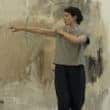Cinematographer Michael McDonough discusses collaborating with Debra Granik and the actors on Leave No Trace, choosing lenses, reflecting how the characters feel about their environment, and applying his TV experience. This is the second article in our Special Issue on Leave No Trace, which is now available as an ebook.
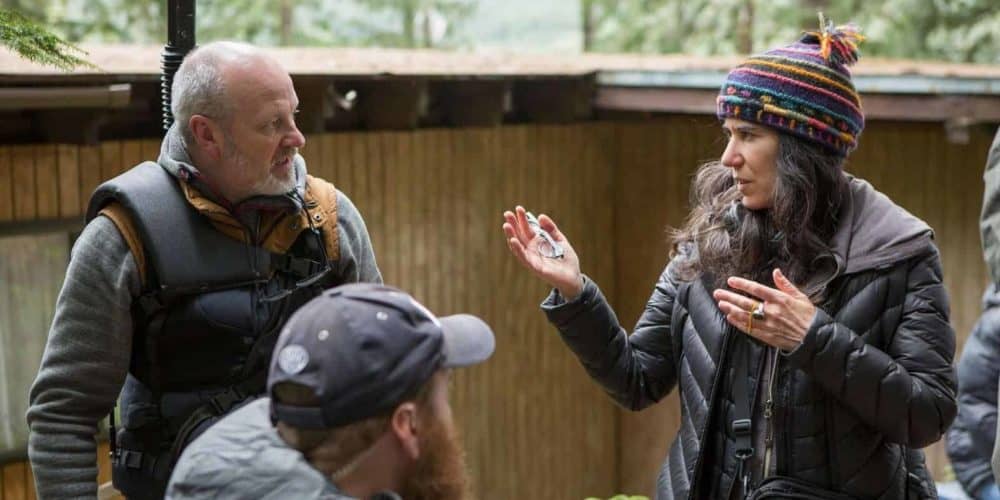
In all of her films to date, Debra Granik has consistently focused on people living in the margins. Down to the Bone (2004) and Winter’s Bone (2010) both centre on characters suffering from a drug addiction that is both the effect of and contributing to their state of near poverty. These characters survive more than they live, and in Leave No Trace, Granik pushes this aspect to symbolic extremes. Ben Foster plays Will, a veteran suffering from PTSD who has cut himself off from civilisation and now lives in a state of survival that he finds preferable to life in society, because only he can control it. In one way or another, and to various degrees, these characters are outsiders. Granik’s interest in them, however, isn’t based in a morbid, superior or patronising fascination, but in a deep desire to understand. Such profound empathy feels so natural within her films that this radical aesthetic of care can be difficult to even perceive on first viewing — Granik doesn’t call attention to her own righteousness; what she cares about are her characters.
Michael McDonough has been the Director of Photography (DOP) on all of Granik’s films to date. His cinematography across all three films presents her characters as three-dimensional human beings, as opposed to caricatures, curiosities, or cardboard stand-ins for ideas. In Leave No Trace, McDonough’s work is instrumental in making truly touching and understandable Will’s plight and his desires, as unusual as those might be. Even more impressive is the way McDonough’s images also — and simultaneously — respect the emotions and longings of Tom (Thomasin McKenzie), Will’s daughter, who does not necessarily agree with her father. The two of them often react to the same situation in diametrically opposing ways, yet we find ourselves able to understand and sympathise with both of them.
McDonough told me about working with colour grading and various lenses to make visible the characters’ feelings for the forest and for the city, learning to shoot fast while working on TV shows such as Fear the Walking Dead and Bosch, using a drone in the film, and collaborating with the lead actors on set.
Seventh Row (7R): You’ve worked with Debra Granik before, but how did you get involved in Leave No Trace?
Michael McDonough: Debra and I went to film school together, and I’ve worked with her on all her previous films. She’d been developing the script for at least five years with some co-producers. Over those years, I would get versions of the script to read and give my thoughts on. The first half of the script is pretty much based on the known facts about the characters. From the point where they go to the horse farm and then leave, no one knows what happened to this family. They never got in touch with anyone. It’s a mystery. When the second half of the script was in development, the question was “what happened to them?” It’d been like that for years and went through several variations, until it was finally settled that the current version was the story we wanted to tell.
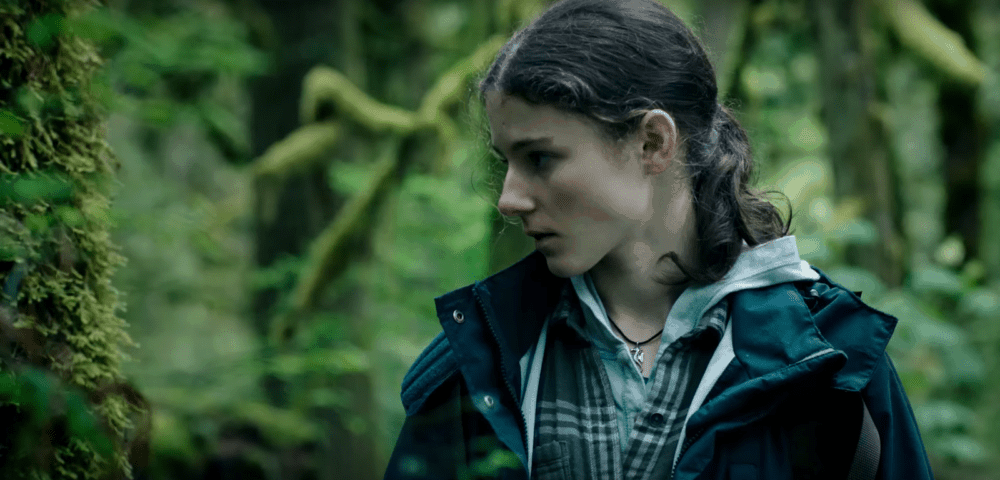
When it got closer to filming, Debra had been traveling from New York up to Portland, Oregon, which was where it was originally set, and looking at locations over the course of maybe a year. It was supposed to film in the fall of 2016. For various reasons, it didn’t happen then. Thankfully, when it pushed to the spring of 2017, I was free and able to go and work on it. So we started. It meant that there was quite a short prep for me, only a few weeks, but because we’d worked together and known each other for so long, we could get into the process of making the film quite quickly.
7R: The forest is neither demonised nor idealised in the film — it doesn’t look like a Disney enchanted forest — and the same goes for the city. Was that always part of your approach? How did you manage to show the forest as a place where of course, there is less comfort than in a house in the city, but where people can still be happy?
Michael McDonough: The approach to filming the forest grew out of wanting to respect the characters’ feelings for the forest. The first part of the film sets up the tone that these are two people who are very comfortable and happy in this place that gives them everything they need. The approach was to cinematically present the feeling of the characters being in a place of comfort and happiness within the woods. I tried to make the woods welcoming, feel like a home. That was set. The photography would adjust for the second half of the story, when they went on their journey.
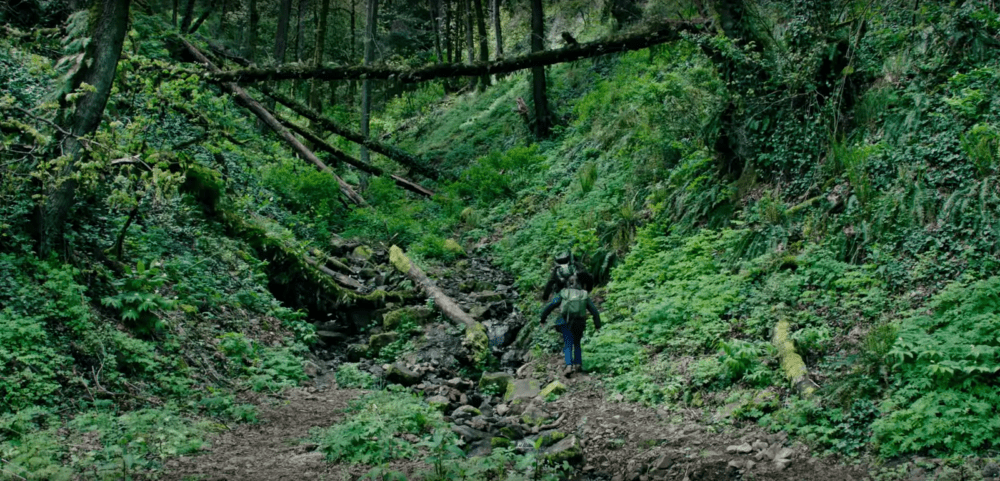
When we were in the forest, we tended to be close to the characters, living close to them within their circle. The camera was handheld; there were wider lenses; and we stood closer to them. And those lenses were lighter lenses: it was soft and warm. They gave out that feeling of comfort.
When we went to the city, the camera was physically farther away from the characters. That way, you feel separated from them just as they’re separated from their comfort and usual surroundings. We went for longer lenses, vantage lenses, zoom lenses, to make it feel less comfortable, to make it feel colder and greyer. We made the audience feel that they’re separated from their home by physically putting space in between the characters.
[click_to_tweet tweet=”‘The approach to filming the forest grew out of wanting to respect the characters’ feelings for the forest.’ – Michael McDonough” quote=”‘The approach to filming the forest grew out of wanting to respect the characters’ feelings for the forest.'”]
That continues a little when they escape and return to the forest, because they’re kind of lost. There’s still a sense of separation and danger. It’s only when Will starts to recover from his injury, and when Tom starts to feel like she’s found a home amongst other people, that we starts to get in closer again and introduce that warmth and comfort back into the film.
[wcm_nonmember]
Want to read the rest of the article?
Get the Leave No Trace ebook
Relive the highs and lows of Debra Granik’s remarkable coming-of-age story and discover how the filmmakers brought it to life.
[/wcm_nonmember]
[wcm_restrict]
7R: You said that the characters are comfortable in the forest, but how was it for you to film there?
Michael McDonough: It had its challenges. We were working with a relatively low budget. We weren’t able to do much lighting and worked mostly with available light. That’s become quite a norm these days; a lot of people are working with available light as a technique. It meant that we could move quite easily from place to place because we didn’t have to bring a lot of gear with us. We had a really great crew in Oregon who are used to working in those locations and conditions. They’re used to dealing with lots of rain, with the terrain of the woods — because it’s not just trees, it’s trees on steep hills!
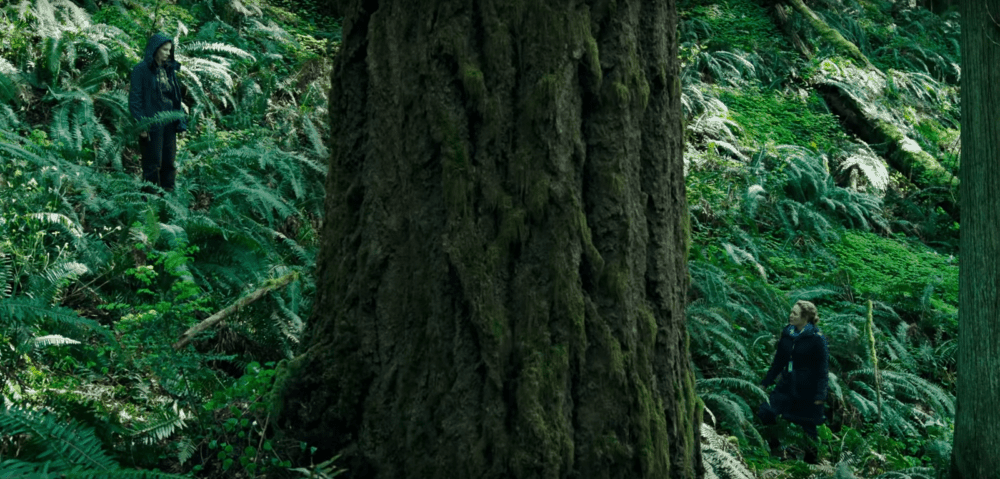
I’m used to working in the US, where I am managing a camera department, with camera operators who are operating and moving the camera, while camera assistants are pulling focus. This is especially true when filming TV, when you’re working with multiple cameras. For Leave No Trace, there was a single camera, and I was operating it myself. That’s more of a European or UK aesthetic. It’s a more controlled way of telling the story, and there’s a more direct connection between the director, the DOP, and the actors.
For maybe one quarter or one half of the film, we had two cameras — one just to get enough coverage or to do steadycam work — and we had very good operators there to help out. But for the majority of the film, it was a single camera, European-style shoot. It was great for me to do that job again. It’s the way I usually work with Debra, because you feel more in the moment and connected. It was physically challenging, but by the end of it, I felt great. It was good exercise.
[click_to_tweet tweet=”‘In the US, I’m used to managing a camera department. For LEAVE NO TRACE, there was a single camera and I was operating it myself. It’s more of a European or UK aesthetic.’ – Michael McDonough” quote=”‘In the US, I’m used to managing a camera department. For LEAVE NO TRACE, there was a single camera and I was operating it myself. It’s more of a European or UK aesthetic.'”]
We had good people and they knew how to deal with the environment. We were so lucky because we weren’t really able to make rain or large storms, but when we wanted it not to rain, it wasn’t raining, and when we wanted some weather, it showed up. Oftentimes, that happens in reverse! In this case, the weather tended to coincide with what we needed for the story, which was also a bonus.
7R: You talked about the two different styles of filming for the urban space and the forest, which are different but well integrated into each other. How did you make sure that they weren’t so different that it would be startling to people?
Michael McDonough: I think that’s partly the actors, because they are the continuity through that. You see the actors, and you feel this unified world. We did work with colours to enhance the colour of the woods more in the final grade, and we desaturated the colour somewhat in the city to create that contrast. I think the main thing would be that, as an audience, you’re just with the characters. The performances are so good, they carry the audience with the story right through.
7R: In the forest, there is this moment where we see overhead shots of the characters walking on a steep hill and the camera gliding above them. How did you do that?
Michael McDonough: We used a drone. Debra likes very simple filming techniques; she likes the camera to either be on a tripod or to be handheld, but quite a controlled handheld, not that busy feel. That’s usually her only two techniques. We used a slider to add a little bit of movement, which she liked. But we had no cranes or dollies or jets or any of that.

The only other new technique for Debra was the drone. We were trying to show these people within this space, to show the vastness of nature with the characters being just little elements within it. The most effective way to shoot that was to use a drone. We had a couple of days worth of drone work. I thought that was pretty effective, especially the shot towards the very end where it shows the tops of the trees. It just gives you that perspective.
[click_to_tweet tweet=”‘The drone allowed us to show the vastness of nature with the character being just little elements within in.’ – Michael McDonough” quote=”‘The drone allowed us to show the vastness of nature with the character being just little elements within in.'”]
I’d always thought of it as a kind of eagle eye view, like an eagle swooping over the landscape. When Will walks away at the end, we see him from that perspective. Not so much God’s perspective, but an eagle’s perspective.
7R: You work in television, as well, which I imagine might be quite a different process. But are there any transferable skills from TV that help you when you work on a film?
Michael McDonough: Absolutely. I’ve been working on a show in LA in the last couple of years that’s been on location. We’re filming on the streets. We have to more very fast. We have to shoot three or four scenes in three or four different locations per day. Going into this film, I think there were some concerns with the landscape, and the amount of work we had to do, that we wouldn’t be able to keep up with a certain kind of schedule.
[click_to_tweet tweet=”‘I’ve always thought of the drone shot from above as a kind of eagle’s perspective — like an eagle swooping over the landscape.’ – Michael McDonough” quote=”‘I’ve always thought of the drone shot from above as a kind of eagle’s perspective — like an eagle swooping over the landscape.'”]
I’ve never had those worries, because I’m used to shooting nine pages of TV a day in Los Angeles. There were a few days where we probably didn’t have enough on our schedule in this film because we had gone through everything faster than planned. I think you learn to work like that on TV just as a necessity. You do the best you can with the time you’re given.
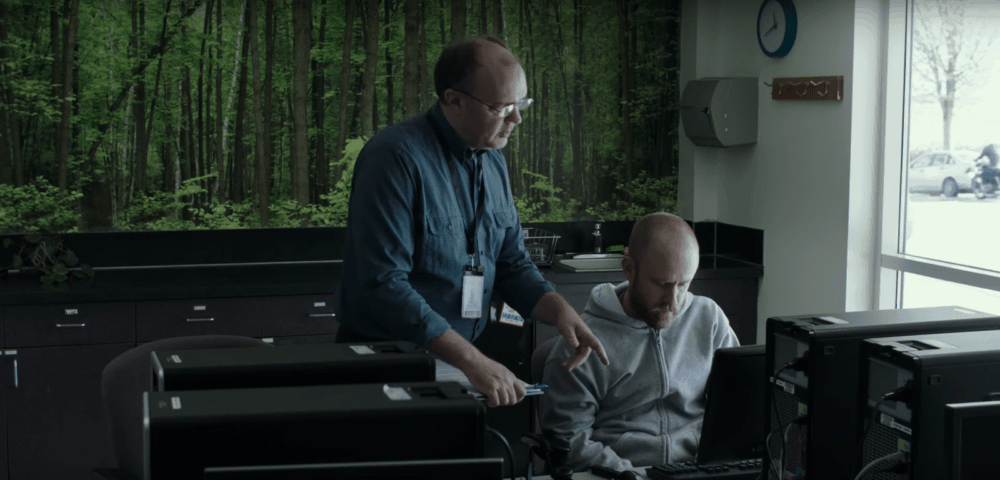
7R: In the city, there are these rather distant shots where the people that Will and Tom meet are reduced to their job. It’s very dehumanising. But when it comes to Tom and Will, we are closer to them; we see their faces more and their emotions. How did you work with the actors? Did you follow them?
Michael McDonough: I think Vera Farmiga, who worked with Debra and I on Debra’s first feature, Down to the Bone (2004), once mentioned that it’s a dance between the camera and the actors. I’d like to think that the actors are free to do whatever they need to do, and your task is to find the angles that work to tell the story.
[click_to_tweet tweet=”‘Because I’m used to shooting nine pages of TV a day, there were a few days while shooting LEAVE NO TRACE where we probably didn’t have enough on our schedule.’ – Michael McDonough” quote=”‘Because I’m used to shooting nine pages of TV a day, there were a few days while shooting LEAVE NO TRACE where we probably didn’t have enough on our schedule.’ – Michael McDonough”]
I think it’s part of the realistic style of this film to make the audience feel that they are there also following what the actors are doing — that things aren’t pre-determined, but unfolding naturally in front of you. That’s one of the main things that handheld camera can do. We would do rehearsals to a degree where I would know roughly what they were going to do, but usually, once you call “action,” it’s really about trying to be in the right place at the right time.
[click_to_tweet tweet=”‘It’s a dance between the camera and the actors. The actors are free to do whatever they need to do, and your task is to find the angles that work to tell the story.’ – Michael McDonough ” quote=”‘It’s a dance between the camera and the actors. The actors are free to do whatever they need to do, and your task is to find the angles that work to tell the story.'”]
7R: Was it very different working with a very experienced actor like Ben Foster and a younger actress like Thomasin?
Michael McDonough: I would say they operate almost exactly the same — Ben from experience, and Thomasin from instincts. She’s incredible. She really has so much professionalism for someone very young, and she was always in character around the camera. She had a sense of what it was doing, even if it was behind her. She was very natural, very instinctual.
Read the rest of the Special Issue on Leave No Trace >>
Subtle cinematography tends to go unnoticed. When Rachel Morrison became the first woman or lesbian cinematographer to be nominated for a Best Cinematography Oscar, it forced many to pay attention. Lena Wilson wrote an extensive essay on Morrison’s deeply empathetic work, one that immerses viewers in the points of view of marginalized characters.
In Lean on Pete, DP Magnus Jønck externalises the emotions of a lonely boy, one that doesn’t fit the template of the usual macho hero of the Western. Orla Smith wrote about the way the landscape of the Western is de-romanticised and purged of its colonialist connotations in both Lean on Pete and in the films of Kelly Reichardt. Rather than reiterate dichotomies and symbolisms of the Old West, Reichardt and Haigh work with their cinematographers to create a visual language that fits their modern, more down-to-earth and empathetic perspectives.
Joshua James Richards was the cinematographer behind two of the most affecting films of 2016. On God’s Own Country, his handheld work let us within the world of the angry, frustrated and lonely farmer Johnny, before letting us share in the character’s newfound sense of hope and openness once he finds love. In The Rider, Richards’ close collaboration with both director Chloé Zhao and the actors, whom he already knew personally, gives the film an atmosphere of intimacy, love, and respect that is simply overwhelming.
[/wcm_restrict]
